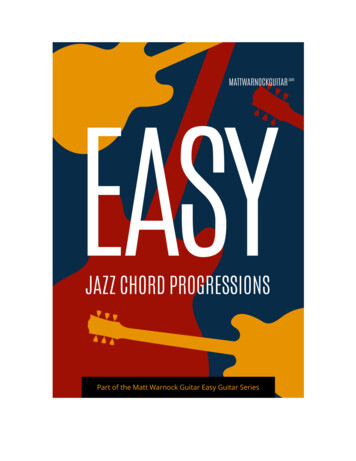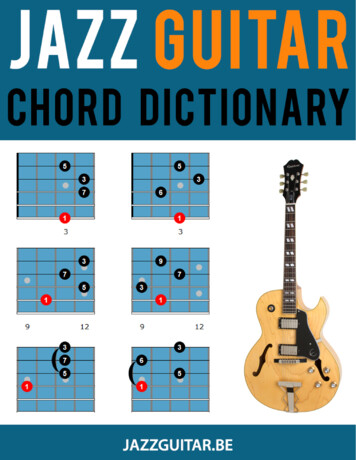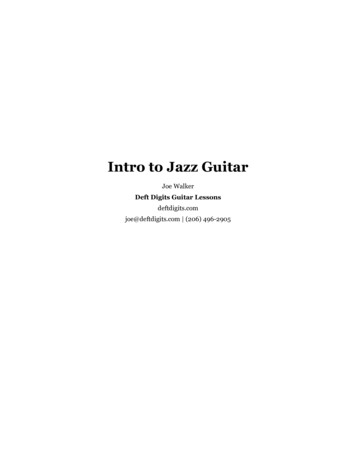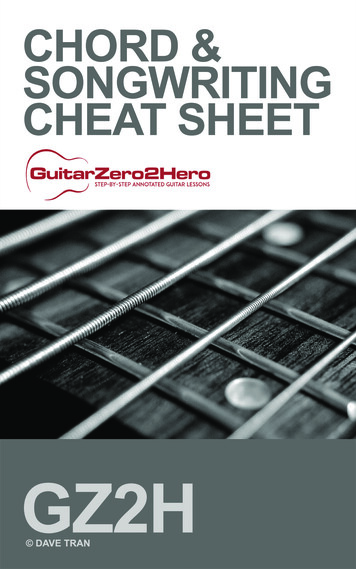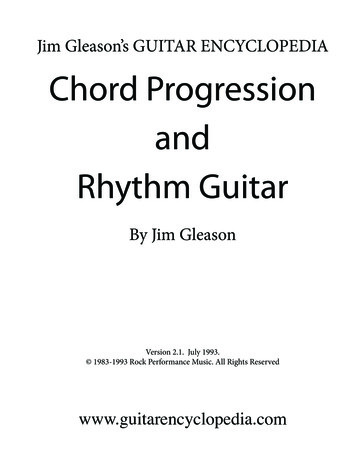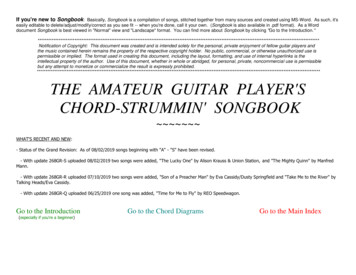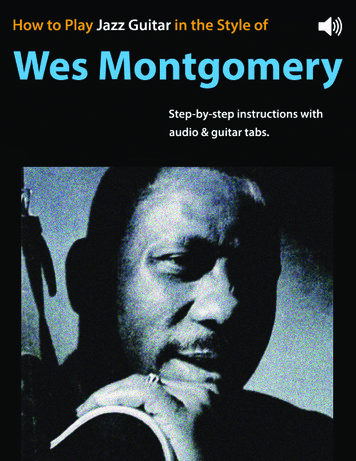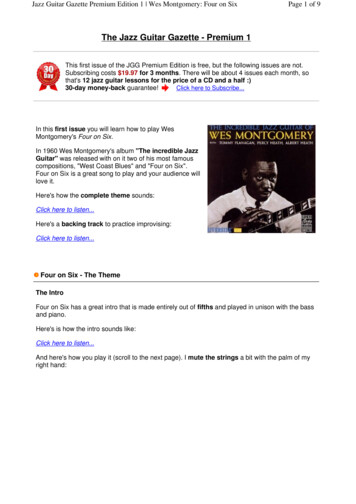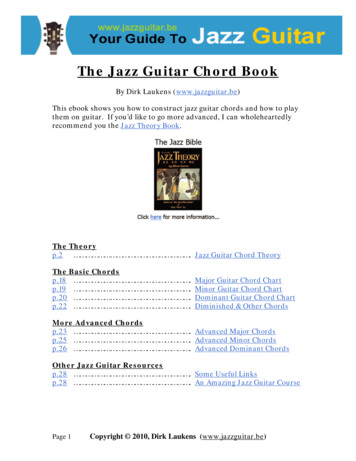
Transcription
The Jazz Guitar Chord BookBy Dirk Laukens (www.jazzguitar.be)This ebook shows you how to construct jazz guitar chords and how to playthem on guitar. If you’d like to go more advanced, I can wholeheartedlyrecommend you the Jazz Theory Book.The Theoryp.2 . Jazz Guitar Chord TheoryThe Basic Chordsp.18 .p.19 .p.20 .p.22 .Major Guitar Chord ChartMinor Guitar Chord ChartDominant Guitar Chord ChartDiminished & Other ChordsMore Advanced Chordsp.23 . Advanced Major Chordsp.25 . Advanced Minor Chordsp.26 . Advanced Dominant ChordsOther Jazz Guitar Resourcesp.28 . Some Useful Linksp.28 . An Amazing Jazz Guitar CoursePage 1Copyright 2010, Dirk Laukens (www.jazzguitar.be)
You are allowed to distribute this free e-book to others. It may howevernot be sold, edited, reprinted in electronic, print, web or other formatwithout express written permission and without mentioning the authorand www.jazzguitar.be Contact: dirk@jazzguitar.beJazz Guitar Chord TheoryIn this tutorial I’ll teach you how guitar chords are built and how thistranslates to the guitar.Let's get started with the C major scale:C Major ScaleC D E F G A B123 4 56 7All chords are based on thirds and there are 2 kinds of thirds (or 3rds) :minor thirdinterval of 3 half notessymbol : b3major thirdinterval of 4 half notessymbol : 3Let's start by stacking 2 thirds on the first note (1) of the C major scale:C E G135The result is a C major triad or C. From C to E is a major third and from Eto G a minor third : every major chord has this structure. The thing toremember here is what we call the chord formula:Chord formula for major chords: 1 3 5Page 2Copyright 2010, Dirk Laukens (www.jazzguitar.be)
Something other things to remember: Another name for the 1 of a chord is the root. A triad is a chord with 3 notes A seventh chord is a chord with 4 or more notesLet's do the same for note 2 of the C major scale:D F A1 b3 5The result is a D minor triad or Dm.From D to F is a minor third and from F to A is a major third : every minorchord has this structure.Chord formula for minor chords: 1 b3 5Let’s skip a few notes and stack thirds on the 7 of the C major scale:B D F1 b3 b5The result is a B diminished triad or Bdim.From B to D is a minor third and from D to F is also a minor third : everydiminished triad chord has this structure.Chord formula for diminished chords: 1 b3 b5Page 3Copyright 2010, Dirk Laukens (www.jazzguitar.be)
I'll summarize and complete the other notes of the C major scale:1NotesFormulaChord NameSymbolC E G135C majorC2 D F A1 b35D minorDm or D- or Dmin3 E G B1 b35E minorEm or E- or Emin4 F A C135F majorF5135G majorG6 A C E1 b35A minorAm or A- or Amin71 b3 b5B diminishedBdim or B G B DB D FBand in a Box 2010 Pro – This intelligent automaticaccompaniment program for your computer allows you topractice guitar with a virtual band. Practicing with Band in aBox is effective, saves time and adds a lot of fun!Click here for more information Now, there are 2 ways to construct chords:1. The first way starts from the major scale.1. Find the major scale of a given key. If you don’t know how to dothis, learn it here: How To Construct a Major Scale. If you need tofind the notes of a Gm chord then find the G major scale : G A B CD E F#2. Construct the major chord : 1 3 5. In our G major example thatwould be : G B DPage 4Copyright 2010, Dirk Laukens (www.jazzguitar.be)
3. Apply the chord formula to the major chord. The chord formulafor minor chords is 1 b3 5. This means the 3rd of the major chordhas to be lowered half a tone: G Bb D2. The second way involves some memorization and will be explained afterwe covered seventh chords and tensions.Let’s have a look at seventh chords, chords that contain 4 or more differentnotes and that are used a lot in jazz music.We start again with the C major scale :C Major ScaleC D E F G A B12 34 56 7The construction of seventh chords follows the same principle as theconstruction of triads : stacking 3rds on top of each other. Triads aremade by stacking 2 thirds on top of the root. Seventh chords areconstructed by stacking 3 thirds on top of the root.Let's stack 3 thirds on the 1 of the C major scale :C E G B135 7The result is a C major 7 chord or Cmaj7.From C to E is a major third, from E to G is a minor third and from G to Bis a major third : every major 7 chord has this structure.Chord formula for major 7 chords: 1 3 5 7Page 5Copyright 2010, Dirk Laukens (www.jazzguitar.be)
Let's do the same for the 2nd note of the C major scale:D F A C1 b3 5 b7The result is a D minor chord or Dmin7.From D to F is a minor third, from F to A is a major third and from A to Cis a minor third: every minor 7 chord has this structure.Chord formula for minor 7 chords: 1 b3 5 b7Let's skip some notes and stack 3 thirds on top of the 5th note of the Cmajor scale:G B D F13 5 b7The result is a G dominant 7 chord or G7.From G to B is a major third, from B to D is a minor third and from D to Fis a minor third : every dominant 7 chord has this structure.Chord formula for dominant 7 chords: 1 3 5 b7Page 6Copyright 2010, Dirk Laukens (www.jazzguitar.be)
We'll skip some more notes and stack 3 thirds on top of the 7th note of theC major scale:B DFA1 b3 b5 b7The result is a B half diminished chord or Bm7b5.From B to D is a minor third, from D to F is a minor third and from F to Ais a major third : every half diminished 7 chord has this structure.Chord formula for half diminished 7 chords: 1 b3 b5 b7I'll summarize and complete the other notes of the C major scale :1NotesFormulaChord NameSymbolC E G B1C major 7Cmaj735 75 b7 D minor 7Dm7 or D-7 orDmin73 E G B D 1 b35 b7E minor 7Em7 or E-7 orEmin74 F A C E135 7F major 7Fmaj75135 b7G dominantG76 A C E G1 b35 b7A minor 7Am7 or A-7 orAmin771 b3 b5 b7B halfdiminishedBm7b5 orBmin7b52 D F A CG B D FB D F APage 71 b3Copyright 2010, Dirk Laukens (www.jazzguitar.be)
The Brazilian Guitar Book – Learn how to play authenticBrazilian guitar. Includes CD and fingerboard diagrams forpeople who are not great readers.Click here for more information Let’s have a look at a phenomenon called tensions.Tensions are notes that are part of a chord, but are not chord tones (13 5 7).Let's have a look again at the C major scale :C Major ScaleC D E F G A B1 23 456 7If we construct a chord on C, we get a Cmaj7 :C E G B1 3 5 7There are 3 notes left in the major scale that are not chord tones : 2, 4and 6. If we add these tones to the chord, they become tensions. Most ofthe time we play tensions an octave higher then the chord tones becauseelse they might get in the way of the chord tones (the chord would sound‘muddy’ most of the time). That's also the way they are notated: 2becomes 9 (2 7(one octave) 9), 4 becomes 11 and 6 becomes 13.So if we add the 2 to Cmaj7 we get Cmaj9C E G B D13Page 85 79Copyright 2010, Dirk Laukens (www.jazzguitar.be)
The two other notes that are left, the 4 and 6, are special cases incombination with a major chord. They are avoid notes: notes that are ahalf tone above a chord tone. Avoid notes sound disharmonic so they arealmost never used.If we have a look at the 4 of the C major scale we notice that it is a half noteabove the e, what is the 3rd of Cmaj7. So the 4 (f) is an avoid note forCmaj7.A solution for this is to raise the 4 half a tone : f becomes f# and is nolonger an avoid note and the basic scale is no longer C major, but C Lydian(see jazz guitar modes). This chord would be called Cmaj7(#11).The 6 is also a special case in combination with major chords. Most of thetimes when we add a 6 to a major chord, the 7 is omitted and there is nooctave added to the 6. This is because the 6 and 7 might get in each other'sway.So if we add the 6 to C major we get a C6 :C E G A135 6The same goes for 6 in combination with a minor chord : the 7 isomitted. If we add the 6 to Dm7 we get Dm6 (Look out : the 6 is no longerA because the root of the chord changed to D. The six is now B (D E F# GA B C#):D F A B1 b3 5 6The 4 is not an avoid note in combination with minor chords becauseit is two half tones above the b3 and not one half. We can safely add the 4to Dm7 and we get Dm11:D F AC1 b3 5b7 11Page 9GCopyright 2010, Dirk Laukens (www.jazzguitar.be)
The 4 is also a special case in combination with dominant chords.When a 4 is added to a dominant chord, the 3 is omitted. Chords like theseare called sus4 chords and often function as a delay for a dominantchord.Sus4 chords often come with a 9 on the guitar :G CDF A1 45b7 9There's also a thing called altered tensions (b9, #9, b5, b13). This topic iscovered later in another lesson.The different chord types and their tensions :Chord TypeMajorMinorDominantPage 10Added NoteSymbol2Cmaj94#4/Cmaj7#11avoid note.#11 comes outof lydian scale6C6omitted 72Cm94Cm116Cm6omitted 72b2#2C9C7(b9)C7#9b2 and #2 comeout of altered scale4C7sus46b6C13C7(b13)b6 comes outof altered scaleCopyright 2010, Dirk Laukens (www.jazzguitar.be)
The Serious Jazz Practice Book – A unique plan for masteringscales, chords, intervals and various melodic patterns.Click here for more information Here's a summary of the chord formulas we covered until now someadditional chord types :Chord TypeChord FormulaMajor Triad1Minor Triad1 b3Diminished Triad1 b3 b5Augmented Triad1 3Major 71Minor 71 b3 5 b7Dominant 71Half Diminished 71 b3 b5 b7Diminished 71 b3 b5 bb7Augmented 71 3#5 b7Suspended 41 45 b7minor/major 71 b35 7Page 1133355#5575 b7Copyright 2010, Dirk Laukens (www.jazzguitar.be)
Let’s look at a shortcut for constructing chords:The first step is memorizing the chords and chord tones of the C majorscale and the chord formula's:Cmaj7C E G BDm7D F A CEm7E G B DFmaj7F A C EG7G B D FAm7A C E GBm7b5B D F A1. You must be able to picture the chord types and chord tones of Cmajor without thinking.2. Now that you know the chords of C major, it's easy to find chords ofother keys.For example: to find the chord tones of Cm7:1.2.3.4.You know the chord tones of Cmaj7: C E G BYou know the chord formula of Cmaj7: 1 3 5 7You know the chord formula of minor 7: 1 b3 5 b7Adapt the chord tones of Cmaj7 to the formula of minor 7:bring the 3 and the 7 a half tone down5. Conclusion: the chord tones of Cm7 are: C Eb G BbExample 2: the chord tones of Ddim7:6.7.8.9.You know the chord tones of Dm7: D F A CYou know the formula of Dm7: 1 b3 5 b7You know the formula of diminished 7: 1 b3 b5 bb7Adapt the chord tones of Dm7 to the formula of diminished 7:bring the 5 and the 7 a half tone down10. Conclusion: the chord tones of Ddim7 are: D F Ab BPage 12Copyright 2010, Dirk Laukens (www.jazzguitar.be)
Example 3: the chord tones of F#7:11. You know the chord tones of Fmaj7: F A C E12. To find the chord tones of F#maj7 you just have to raise eachchord tone half a tone: F# A# C# E#13. You know the formula of major 7: 1 3 5 714. You know the formula of dominant 7: 1 3 5 b715. Adapt the chord tones of F#maj7 to the formula of dominant 7: bring the 7 a half tone down16. Conclusion: the chord tones of F#7 are: F# A# C# ENow you know how to find the notes of a chord, but how do you translatethis to the guitar?One thing you need to know is that not every chord tone is equallyimportant : 3 and 7 are the important notes of a chord because they decidewhat kind of chord we are dealing with.The 1 is the least important note, because it is played by the bassplayer most of the time.The 5 is not so important either and can be disturbing sometimes.Tensions add color and interest to a chord, so it's preferable touse tensions instead of 1 and 5Another thing you need to know is that 1 half tone equals one fret on theguitar.Let’s have a look at some examples:We'll start with a C triad: C E G (1 3 5)X15135 : CPage 13Copyright 2010, Dirk Laukens (www.jazzguitar.be)
from left to right (from low E string to high E string) we have:ooooooX: the low E-string is not played1: the 1 or root of the chord is played on the A-string5: the 5th of the chord is played on the D-string1: again the root, but now on the G-string3: the third is played on the B-string5: the 5th is played again, but this time on the high E-stringYou see that it is ok to duplicate chord tones, like the 1 and the 5 in ourexample, but this may sound a bit sluggish.This chord doesn't sound very jazzy though, let's spice it up a bit:X15735 : Cmaj7Instead of duplicating the root on the G-string, we exchanged it for the 7 ofthe chord.Now let's add some color :X1379X : Cmaj9Page 14Copyright 2010, Dirk Laukens (www.jazzguitar.be)
We exchanged the 5th on the D-string for the 3rd and we changed the 3rdon the B-string to a 9.This would be a nice chord if you're playing bossa nova, solo guitar or induo setting, but if you play with a bass player and you don't want to get inhis way, it's better to omit the root and to play on the higher strings only:XX3795 : Cmaj9/EInstead of playing the root of the chord, we now play the 5th on the high Estring.A chord like this is called a chord inversion: a chord that has a noteother than the root in the bass.There are three types of chord inversions: First inversion: 3rd in the bass Second inversion: 5th in the bass Third inversion: 7th in the bassIn our example we have got a Cmaj9 chord with the 3rd (E) in the bass.Now what needs to happen if we want to make this chord dominant?Simple: the 7 has to go a half tone down (major is 1 3 5 7, dominant is 1 3 5b7).Page 15Copyright 2010, Dirk Laukens (www.jazzguitar.be)
Have a look at the chord diagram:XX3b795 : C9/EAnd if we want to make this chord minor?Starting from the dominant chord we have to lower the 3rd with half atone, as you can see here:XXb3b795 : Cm9/EHere’s an exercise for you: I give you some chords and you need to find thechord notes (the solutions are on the next page) :For example :
Triads are made by stacking 2 thirds on top of the root. Seventh chords are constructed by stacking 3 thirds on top of the root. Let's stack 3 thirds on the 1 of the C major scale : C E G B 1 3 5 7 The result is a C major 7 chord or Cmaj7. From C to E is a major third, from E to G is a minor third and from G to B is a major third : every major 7 chord has this structure. Chord formula for .
